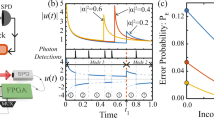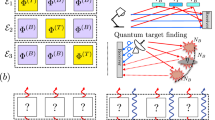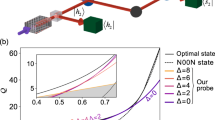Abstract
Measurement of the state of a quantum system with inherent quantum uncertainty (noise) approaching the ultimate physical limits is of both technological and fundamental interest. Quantum noise prevents any mutually nonorthogonal quantum states, such as coherent states, from being distinguished with perfect accuracy. Optimized quantum measurements for nonorthogonal coherent states allow, in principle, for state discrimination sensitivities surpassing the standard quantum limit. Realizing quantum receivers that can detect multiple coherent states with sensitivity levels approaching the ultimate quantum limits is fundamental to quantum-enhanced measurements, and can optimize the performance of quantum and classical communications as well as future implementations of quantum technologies. Here, we demonstrate the first quantum receiver that unconditionally discriminates four nonorthogonal coherent states with error probabilities below the standard quantum limit. This receiver achieves error rates four times lower than is possible with any ideal conventional receiver with perfect detection efficiency.
This is a preview of subscription content, access via your institution
Access options
Subscribe to this journal
Receive 12 print issues and online access
$209.00 per year
only $17.42 per issue
Buy this article
- Purchase on Springer Link
- Instant access to full article PDF
Prices may be subject to local taxes which are calculated during checkout




Similar content being viewed by others
References
Helstrom, C. W. Quantum Detection and Estimation Theory, Mathematics in Science and Engineering 123 (Academic Press, 1976).
Caves, C. M. & Drummond, P. D. Quantum limits on bosonic communication rates. Rev. Mod. Phys. 66, 481–537 (1994).
Grosshans, F. & Grangier, P. Continuous variable quantum cryptography using coherent states. Phys. Rev. Lett. 88, 057902 (2002).
Grosshans, F. et al. Quantum key distribution using Gaussian-modulated coherent states. Nature 421, 238–241 (2003).
Betti, S., De Marchis, G. & Iannone, E. Coherent Optical Communications Systems (Wiley, 2000).
Weedbrook, C. et al. Gaussian quantum information. Rev. Mod. Phys. 84, 621–669 (2012).
Munro, W. J., Nemoto, K. & Spiller, T. P. Weak nonlinearities: a new route to optical quantum computation. New J. Phys. 7, 137 (2005).
Van Loock, P. Optical hybrid approaches to quantum information. Laser Photon. Rev. 5, 167–200 (2011).
Nemoto, K. & Munro, W. J. Nearly deterministic linear optical controlled-not gate. Phys. Rev. Lett. 93, 250502 (2004).
Ralph, T. C., Gilchrist, A., Milburn, G. J., Munro, W. J. & Glancy, S. Quantum computation with optical coherent states. Phys. Rev. A 68, 042319 (2003).
Wiseman, H. M. Adaptive phase measurements of optical modes: going beyond the marginal Q distribution. Phys. Rev. Lett. 75, 4587–4590 (1995).
Armen, M. A., Au, J. K., Stockton, J. K., Doherty, A. C. & Mabuchi, H. Adaptive homodyne measurement of optical phase. Phys. Rev. Lett. 89, 133602 (2002).
Wiseman, H. & Milburn, G. Quantum Measurement and Control (Cambridge Univ. Press, 2010).
Gisin, N., Ribordy, G., Tittel, W. & Zbinden, H. Quantum cryptography. Rev. Mod. Phys. 74, 145–195 (2002).
Bennett, C. H. Quantum cryptography using any two nonorthogonal states. Phys. Rev. Lett. 68, 3121–3124 (1992).
Huttner, B., Imoto, N., Gisin, N. & Mor, T. Quantum cryptography with coherent states. Phys. Rev. A 51, 1863–1869 (1995).
Giovannetti, V. et al. Classical capacity of the lossy bosonic channel: the exact solution. Phys. Rev. Lett. 92, 027902 (2004).
Agarwal, G. S. Fiber-Optic Communication Systems (Wiley, 2010).
Weedbrook, C. et al. Quantum cryptography without switching. Phys. Rev. Lett. 93, 170504 (2004).
Sych, D. & Leuchs, G. Coherent state quantum key distribution with multi letter phase-shift keying. New J. Phys. 12, 053019 (2010).
Leverrier, A. & Grangier, P. Unconditional security proof of long-distance continuous-variable quantum key distribution with discrete modulation. Phys. Rev. Lett. 102, 180504 (2009).
Proakis, J. G. Digital Communications 4th edn (McGraw-Hill, 2000).
Kennedy, R. S. A near-optimum receiver for the binary coherent state quantum channel. MIT Res. Lab. Electron. Quart. Progr. Rep. 110, 219–225 (1972).
Dolinar, S. J. A optimum receiver for the binary coherent state quantum channel. MIT Res. Lab. Electron. Quart. Progr. Rep. 111, 115–120 (1973).
Dolinar, S. J. Jr. A Class of Optical Receivers Using Optical Feedback. PhD thesis, Massachusetts Institute of Technology (1976).
Sasaki, M. & Hirota, O. Optimum decision scheme with a unitary control process for binary quantum-state signals. Phys. Rev. A 54, 2728–2736 (1996).
Takeoka, M. & Sasaki, M. Discrimination of the binary coherent signal: Gaussian-operation limit and simple non-Gaussian near-optimal receivers. Phys. Rev. A 78, 022320 (2008).
Wittmann, C. et al. Demonstration of near-optimal discrimination of optical coherent states. Phys. Rev. Lett. 101, 210501 (2008).
Cook, R. L., Martin, P. J. & Geremia, J. M. Optical coherent state discrimination using a closed-loop quantum measurement. Nature 446, 774–777 (2007).
Tsujino, K. et al. Sub-shot-noise-limit discrimination of on-off keyed coherent signals via a quantum receiver with a superconducting transition edge sensor. Opt. Express 18, 8107–8114 (2010).
Tsujino, K. et al. Quantum receiver beyond the standard quantum limit of coherent optical communication. Phys. Rev. Lett. 106, 250503 (2011).
Dolinar, S. J. Jr. A Near-Optimum Receiver Structure for the Detection of M-ary Optical PPM Signals, Telecommunication and Data Acquisition Progress Report 42–72, October–December 1982 (Jet Propulsion Laboratory, 1983).
Bondurant, R. S. Near-quantum optimum receivers for the phase-quadrature coherent-state channel. Opt. Lett. 18, 1896–1898 (1993).
Becerra, F. E. et al. m-ary-state phase-shift-keying discrimination below the homodyne limit. Phys. Rev. A 84, 062324 (2011).
Muller, C. et al. QPSK coherent state discrimination via a hybrid receiver. New J. Phys. 14, 083009 (2012).
Izumi, S. et al. Displacement receiver for phase-shift-keyed coherent states. Phys. Rev. A 86, 042328 (2012).
Nair, R., Yen, B. J., Guha, S., Shapiro, J. H. & Pirandola, S. Symmetric m-ary phase discrimination using quantum-optical probe states. Phys. Rev. A 86, 022306 (2012).
Chen, J., Habif, J. L., Dutton, Z., Lazarus, R. & Guha, S. Optical codeword demodulation with error rates below the standard quantum limit using a conditional nulling receiver. Nature Photon. 6, 374–379 (2012).
Higgins, B. L., Berry, D. W., Bartlett, S. D., Wiseman, H. M. & Pryde, G. J. Entanglement-free Heisenberg-limited phase estimation. Nature 450, 393–396 (2007).
Xiang, G. Y., Higgins, B. L., Berry, D. W., Wiseman, H. M. & Pryde, G. J. Entanglement-enhanced measurement of a completely unknown optical phase. Nature Photon. 5, 43–47 (2011).
Zhang, L. et al. Mapping coherence in measurement via full quantum tomography of a hybrid optical detector. Nature Photon. 6, 364–368 (2012).
PicoQuant, model Tau-SPAD-100. http://www.picoquant.com/products/tau_spad/tau_spad.htm
Gentile, T. R., Houston, J. M. & Cromer, C. L. Realization of a scale of absolute spectral response using the National Institute of Standards and Technology high-accuracy cryogenic radiometer. Appl. Opt. 35, 4392–4403 (1996).
Acknowledgements
F.E.B. thanks S. Polyakov and A. Restelli for fruitful discussions about FPGA programming and low-noise electronic design, respectively, and I. Spielman for providing the laser diode at 780 nm.
Author information
Authors and Affiliations
Contributions
F.E.B. designed the experimental implementation of the receiver, performed the measurements and analysed the experimental results. J.F. and A.M. provided assistance. J.G., J.K. and G.B. conceived the initial theoretical measurement strategy. All authors contributed to writing the manuscript.
Corresponding author
Ethics declarations
Competing interests
The authors declare no competing financial interests.
Rights and permissions
About this article
Cite this article
Becerra, F., Fan, J., Baumgartner, G. et al. Experimental demonstration of a receiver beating the standard quantum limit for multiple nonorthogonal state discrimination. Nature Photon 7, 147–152 (2013). https://doi.org/10.1038/nphoton.2012.316
Received:
Accepted:
Published:
Issue Date:
DOI: https://doi.org/10.1038/nphoton.2012.316
This article is cited by
-
Demonstration of \(\mathcal{P}\mathcal{T}\)-symmetric quantum state discrimination
Quantum Information Processing (2024)
-
Discriminating mixed qubit states with collective measurements
Communications Physics (2023)
-
Resolution of 100 photons and quantum generation of unbiased random numbers
Nature Photonics (2023)
-
Optomechanical cavity-atom interaction through field coupling in a composed quantum system: a filtering approach
Applied Physics B (2023)
-
Determination of the asymptotic limits of adaptive photon counting measurements for coherent-state optical phase estimation
npj Quantum Information (2022)



